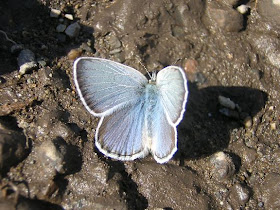Green hairstreaks, or "greenies" as many lepidopterists call them, are small, rather dull-looking butterflies at first glance, but have beautiful emerald green scaling on the underside of their wings. There are four species in the northwest, but these are in dispute as to which should be separated or lumped into new or existing species or subspecies. The two species found in the eastern sage-steppe of WA and OR, are
Callophrys affinis (western green hairstreak) and
Callophrys sheridanii (Sheridan's green hairstreak). These two butterflies are often the first to emerge in the spring before other butterflies. It is difficult to differentiate between the two, but Sheridan's is usually smaller, has more black scaling on the underside, and the white line on the VHW (ventral hind wing) is often more prominent than in the western green hairstreak. The white line is sometimes missing in the western green, as seen in the following photo. In older individuals, the green scales may be partially or mostly worn off, such as with the individual on the far left in the photo.
 |
| C. sheridanii (three on the left) and C. affinis (right) from Okanogan County |
Their perching habits also differ, in that the western green hairstreak tends to perch on and fly from the tops of shrubs, while Sheridan's tends to perch on and fly very close to the ground. The larvae of both species feed on buckwheats (
Eriogonum), including
Eriogonum umbellatum and
E. heracleoides. Western green hairstreak larvae feed on the flowers, while Sheridan's green larvae feed on the leaves. The pupae overwinter, and the adults emerge as soon as the weather begins to warm up in the spring, usually in March for lower elevations, and as late as June or July at higher elevations.
The following photo is of a greenie I caught in a meadow on Red Top Mountain in Kittitas County last July. This is one of those cases where it is difficult to determine which species this is, particularly since I and the group I was leading found one of each on that day, but I don't have a photo of the other individual, and can't remember which species we decided this was. See if you can figure it out!















































